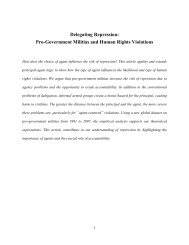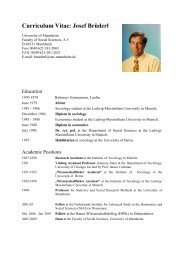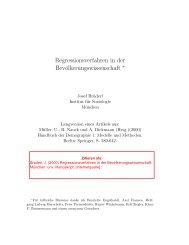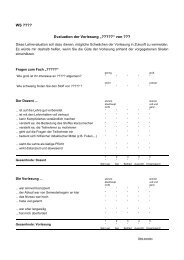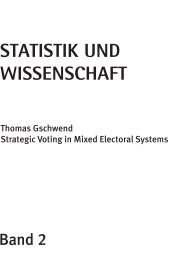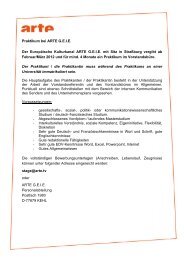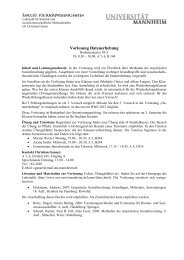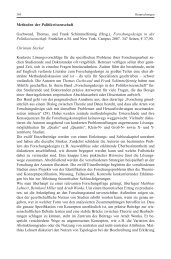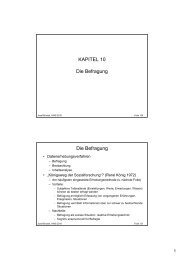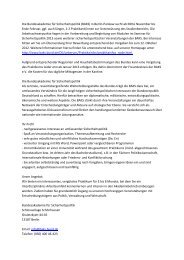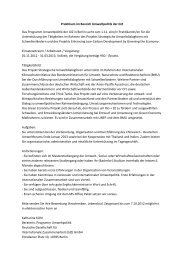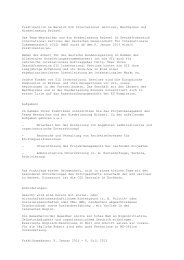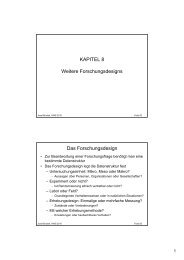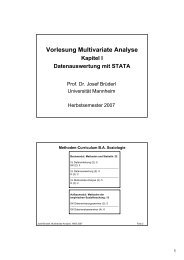Panel Data Analysis, Josef Brüderl - Sowi
Panel Data Analysis, Josef Brüderl - Sowi
Panel Data Analysis, Josef Brüderl - Sowi
You also want an ePaper? Increase the reach of your titles
YUMPU automatically turns print PDFs into web optimized ePapers that Google loves.
<strong>Panel</strong> <strong>Data</strong> <strong>Analysis</strong>, <strong>Josef</strong> Brüderl 20<br />
models!<br />
So why bother with "dynamic" panel models at all?<br />
• These are the "classic" methods for panel data analysis. Already in the 1940ies<br />
Paul Lazarsfeld analyzed turnover tables, a method that later was generalized to<br />
the "cross-lagged panel model". The latter was once believed to be a panacea<br />
for the analysis of cause and effect. Meanwhile several authors concluded that it<br />
is a "useless" method for identifying causal effects.<br />
• You may have substantive interest in the estimate of , the "stability" effect.<br />
This, however, is not the case in "analyzing the effects of events" applications. I<br />
suppose there are not many applications where you really have a theoretical<br />
interest in the stability effect. (The fact that many variables tend to be very<br />
similar from period to period is no justification for dynamic models. This stability<br />
also captured in static models (by i ).)<br />
• Including y i,t−1 is another way of controlling for unobserved heterogeneity. This<br />
is true, but this way of controlling for unobserved heterogeneity is clearly inferior<br />
to within estimation (much more untestable assumptions are needed).<br />
• Often it is argued that static models are biased in the presence of measurement<br />
error, regression toward the mean, etc. This is true as we discussed above<br />
(endogeneity). However, dynamic models also have problems with endogeneity.<br />
Both with static and dynamic models one has to use IV-estimation under<br />
endogeneity. Thus, it is not clear why these arguments should favor dynamic<br />
models.<br />
Our example: The pooled-OLS-, RE-, and FE-estimator of the marriage effect in a<br />
model with lagged wage are 125, 124, and 495 respectively. All are biased. So I<br />
can see no sense in using a "dynamic" panel model.<br />
Conditional Fixed-Effects Models<br />
The FE-methodology applies to other regression models also. With non-linear<br />
regression models, however, it is not possible to cancel the i by demeaning the<br />
data. They enter the likelihood as "nuisance-parameters". However, if there exists a<br />
sufficient statistic allowing the fixed-effects to be conditioned out of the likelihood,<br />
the FE-model is estimable nevertheless (conditional likelihood). This is not the case<br />
for all non-linear regression models. It is the case for count data regression models<br />
(xtpoisson, xtnbreg) and for logistic regression.<br />
For other regression models one could estimate unconditional FE-models by<br />
including person-dummies. Unconditional FE-estimates are, however, biased. The<br />
bias gets smaller the larger T becomes.<br />
Fixed–Effects Logit (Conditional Logit)<br />
This is a conventional logistic regression model with person-specific fixed-effects i :



